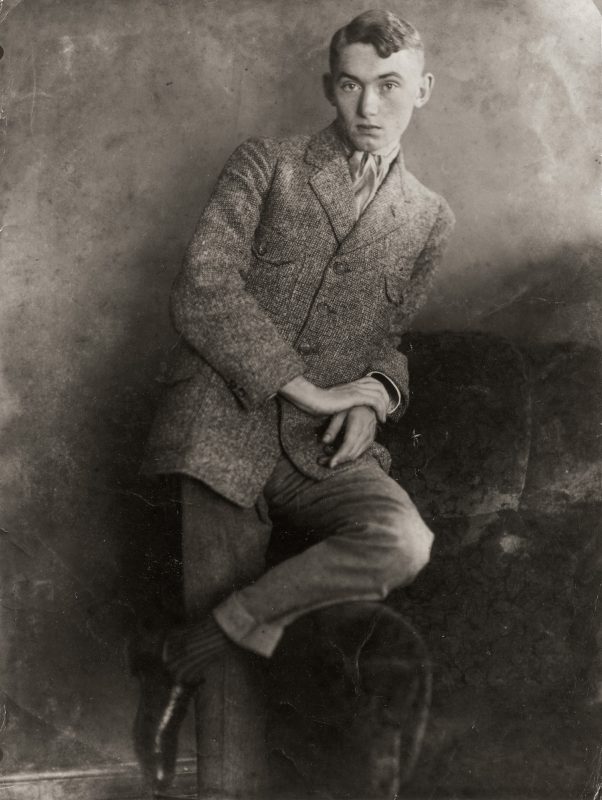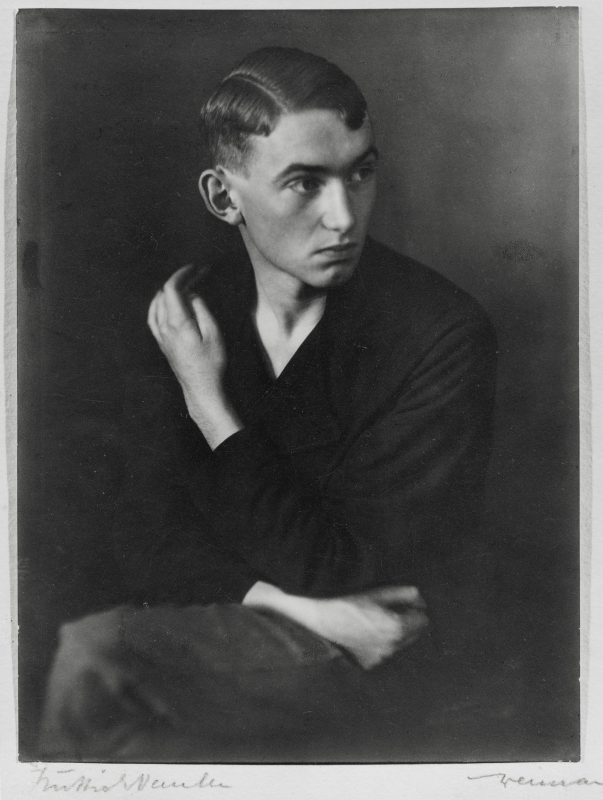1919–1926

By 1919, Max Peiffer was already a law clerk at the Hattingen district court.
By an act of the District President of the town of Arnsberg on September 4, 1919, he added to his family name Peiffer, the family name of his stepfather Watenphul, thereafter calling himself Max Peiffer Watenphul.
In the autumn of 1919, Peiffer Watenphul decided to set aside his legal career and devote himself entirely to painting. On the advice of Lily Klee, he went to Johannes Itten at the Staatliches Bauhaus in Weimar.
Max Peiffer Watenphul attended Johannes Itten’s preliminary course at the Bauhaus in Weimar from the autumn of 1919 to the summer of 1922. He received permission from Walter Gropius to look on in all the workshops, and was also given a studio of his own.
The artist spoke of life at the Weimar Bauhaus in the following words:

“The groups of students gathered around the masters at the Bauhaus varied broadly in age, background, and gifts. The circle around Itten, still young and passionate, was the one most full of contradictions. It was largely comprised of young Viennese intellectuals and other enthusiasts. There were frequent heated discussions, since everyone was in revolt against traditional concepts and ceaselessly sought the new. We were poor, sustained ourselves from meager fare, and froze in the unheated studios. But we sought with great élan to set aside the quarrels and joys of life and shape from them a worldview that might be called nearly religious. We clothed ourselves in rags that, though cheap, we draped on ourselves in painterly fashion. Some of us painted our shoes a different color every day, or wore Russian frocks adorned with pectoral crosses on necklaces. The many celebrations with barefoot dancing to the music of the Bauhaus band often had a nearly cultic feel….
The outline of the teaching was not fixed, but rather, very mobile. Experiments were made, and the environment incorporated into teaching. For example, we cooked according to Mazdaznan—a way of life seeking to renew the wisdom of Zarathustra, and which had many followers in the years after World War I—did gymnastics to be flexible before nude drawing, and listened to Gertrud Grunow’s lessons on strengthening the human productive powers. Wandering preachers appeared who were ridiculed or who enthralled people, who then joined them on their wanderings or joined monasteries. In the summer, there were impressive lantern festivals, and we bathed nude in the Ilm by moonlight. These were harmless romantic pleasures, but the citizens of Weimar regarded them as the vastly mad debauches of the already notorious and infamous people of the Bauhaus…. We found the evening events inspiring, diverting, and sometimes thrilling: lectures, debates, and concerts with prominent poets, philosophers, and artists from Germany, Austria, and Switzerland. A reading by Else Lasker-Schüler I remember vividly. The Viennese contingent had decorated the hall with prayer rugs and candles. The little poetess with the gypsy-like face had an immensely dignified presence, and she spoke her poems, which moved us deeply. Her friend Theodor Däubler also read us his deep poems filled with visionary views. Franz Werfel came, as did his wife Alma Mahler, the widow of the composer, who interested us very much. After all, she had been painted by Oskar Kokoschka, and she was very famous. The days in Weimar were always colorful, lively, and never boring.” (B. Bilzer, Max Peiffer Watenphul (Göttingen, 1974), pp. 8–9)
At the Bauhaus in Weimar, Peiffer Watenphul knew and attended the classes of Lyonel Feininger and Wassily Kandinsky, and he also knew Josef Albers. He worked in the lithograph workshop as well, where he made his first lithographs. Peiffer Watenphul’s friends included Kurt Schwitters, Oskar Schlemmer, Gerhard Marcks, Else Lasker-Schüler, Max Buchartz, Werner Gilles, Grete Willers, Vally Neumann, and Paul Klee, who had begun teaching at the Bauhaus in 1921, and his wife Lily.
Peiffer Watenphul was a member, from 1920 onward, in the group of artists Das Junge Rheinland, and exhibited with them regularly. The art dealer Alfred Flechtheim, who had a gallery in Düsseldorf, put Peiffer Watenphul under contract, which made him financially independent. Ernst Gosebruch organized a first exhibition of Peiffer Watenphul’s works at the Kunstmuseum in Essen in 1921. The artist also befriended the collector Klaus Gebhard in Wuppertal. Peiffer Watenphul took his first trip to Salzburg and Vienna in the summer of 1920. This was the beginning of the artist’s close connection to Salzburg, which endured throughout his life. This was also the period in which the artist became acquainted with Stefan Zweig and his wife Friederike, Hugo and Gerty von Hofmannsthal, Richard Billinger, and Robert Neumann.

with Maria Cyrenius, 1921
He traveled to Italy for the first time in November of 1921. Via Rome and Naples, he went to Positano, where Karli Sohn-Rethel and Werner Heuser awaited him. Peiffer Watenphul was in Rome in January of 1922. His first encounter with Italy was a disappointment. He had imagined a country strewn with flowers, and instead, everything was gray on gray. In the Eternal City, he lived in an unheated studio that had been made available to him. He chose to return to Germany via Salzburg. Back at the Bauhaus in Weimar, the artist worked in the weaving workshop. There, he created the tapestry (illustration) that the pupil gave to Johannes Itten on his departure in 1923.
In the summer of 1922, the artist worked in the Salzburg enamel workshop of Maria Cyrenius. In the autumn of 1922, he met Alexej von Jawlensky through Klaus Gebhard in Wuppertal, and the two men became friends. Jawlensky was the painter who inspired Peiffer Watenphul, in the latter’s own words, “to bring color into his paintings.” Jawlensky owned a landscape by Peiffer Watenphul that burned in his studio during a 1945 air raid on Wiesbaden.
Peiffer Watenphul was in Düsseldorf from the fall of 1922 until February of 1923, living in a studio provided by Ms. Sohn-Rethel. Among his acquaintances and friends at the time were Otto Pankok, Gert Heinrich Wollheim, Otto and Martha Dix, Max Ernst, Johanna Ey, J. Baptist Hermann Hundt, and Hans Koch. The occupation of the Ruhr region by the French in 1923 forced the artist to spend an extended period of time at his parents’ house in Hattingen. In the autumn, he spent fifteen days working in the Wuppertal workshop of the goldsmith Karl Krall. The collector Klaus Gebhard gave him financial support during these years. Weimar remained his official residence until the end of 1923.
On July 1, 1924, Max Peiffer Watenphul departed on a freighter to Cuba and on to Veracruz in Mexico, continuing over land to Mexico City. The artist stayed until February 4, 1925, supporting himself by teaching painting, and painting sets and posters for the theater groups of German clubs. He traveled through Mexico, in particular the province of Morelos and the surroundings of Mexico City with the writer Wilhelm Pferdekamp. Peiffer Watenphul was interested in Mexican folk painting. This was the period in which he painted the large Mexican landscapes with their strong colors, already anticipating the later southern landscapes in their form and construction. He took a freight steamer back to Hamburg in February.
He spent August of 1926 with Maria Cyrenius in Ragusa (now Dubrovnik, Croatia). He traveled to the south of France in the autumn of 1926. In December, he was in Paris, and then went on to Florence and Rome.
